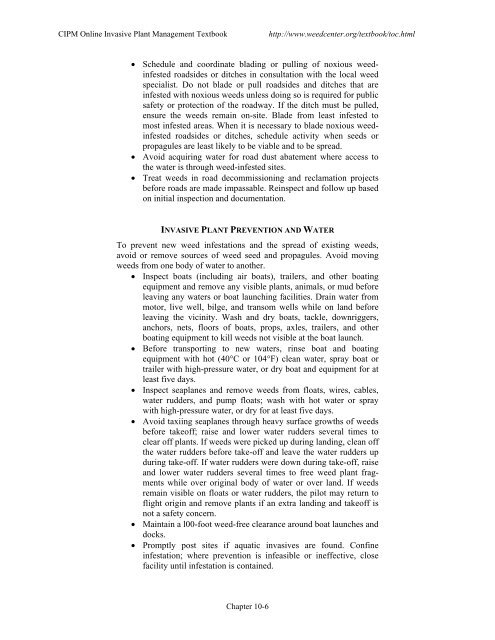Chapter 10 - Center for Invasive Plant Management
Chapter 10 - Center for Invasive Plant Management
Chapter 10 - Center for Invasive Plant Management
You also want an ePaper? Increase the reach of your titles
YUMPU automatically turns print PDFs into web optimized ePapers that Google loves.
CIPM Online <strong>Invasive</strong> <strong>Plant</strong> <strong>Management</strong> Textbookhttp://www.weedcenter.org/textbook/toc.html• Schedule and coordinate blading or pulling of noxious weedinfestedroadsides or ditches in consultation with the local weedspecialist. Do not blade or pull roadsides and ditches that areinfested with noxious weeds unless doing so is required <strong>for</strong> publicsafety or protection of the roadway. If the ditch must be pulled,ensure the weeds remain on-site. Blade from least infested tomost infested areas. When it is necessary to blade noxious weedinfestedroadsides or ditches, schedule activity when seeds orpropagules are least likely to be viable and to be spread.• Avoid acquiring water <strong>for</strong> road dust abatement where access tothe water is through weed-infested sites.• Treat weeds in road decommissioning and reclamation projectsbe<strong>for</strong>e roads are made impassable. Reinspect and follow up basedon initial inspection and documentation.INVASIVE PLANT PREVENTION AND WATERTo prevent new weed infestations and the spread of existing weeds,avoid or remove sources of weed seed and propagules. Avoid movingweeds from one body of water to another.• Inspect boats (including air boats), trailers, and other boatingequipment and remove any visible plants, animals, or mud be<strong>for</strong>eleaving any waters or boat launching facilities. Drain water frommotor, live well, bilge, and transom wells while on land be<strong>for</strong>eleaving the vicinity. Wash and dry boats, tackle, downriggers,anchors, nets, floors of boats, props, axles, trailers, and otherboating equipment to kill weeds not visible at the boat launch.• Be<strong>for</strong>e transporting to new waters, rinse boat and boatingequipment with hot (40°C or <strong>10</strong>4°F) clean water, spray boat ortrailer with high-pressure water, or dry boat and equipment <strong>for</strong> atleast five days.• Inspect seaplanes and remove weeds from floats, wires, cables,water rudders, and pump floats; wash with hot water or spraywith high-pressure water, or dry <strong>for</strong> at least five days.• Avoid taxiing seaplanes through heavy surface growths of weedsbe<strong>for</strong>e takeoff; raise and lower water rudders several times toclear off plants. If weeds were picked up during landing, clean offthe water rudders be<strong>for</strong>e take-off and leave the water rudders upduring take-off. If water rudders were down during take-off, raiseand lower water rudders several times to free weed plant fragmentswhile over original body of water or over land. If weedsremain visible on floats or water rudders, the pilot may return toflight origin and remove plants if an extra landing and takeoff isnot a safety concern.• Maintain a l00-foot weed-free clearance around boat launches anddocks.• Promptly post sites if aquatic invasives are found. Confineinfestation; where prevention is infeasible or ineffective, closefacility until infestation is contained.<strong>Chapter</strong> <strong>10</strong>-6
















